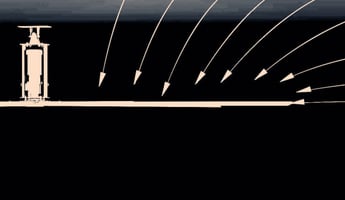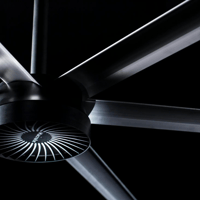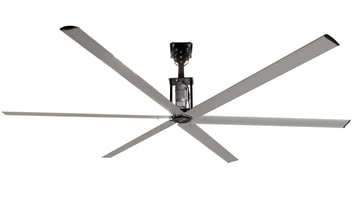High volume, low speed (HVLS) fans are becoming increasingly popular in warehouse and production...
Be Aware of These 6 Industrial Fan Safety Hazards
In a warehouse or distribution center, employee safety is always the first concern especially when working with industrial equipment. Industrial fans are no exception. The first and foremost concern is protecting yourself and your employees from the rotating blades, but there are also other industrial fan safety hazards associated with working with industrial fan equipment. This blog will focus on 6 industrial ceiling fan safety tips to ensure a safe environment.
1. Direct Contact with Rotating Blades
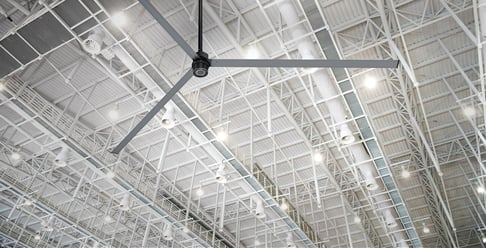
Challenge:
The most significant risk to occupational safety and health that could come from industrial fans is close or direct contact with the fan blades. Close proximity to the fan blades can cause the following:
- Blowing dust or dirt, which is particularly hazardous to eyes and human or animal health.
- High-speed airflow can knock you off of your feet.
- Bodily harm or injury when actually coming in contact with the fan blades.
Solution:
Unlike floor fans or high-speed blowers, large industrial ceiling fans are mounted high above employees. Also, large industrial ceiling fans output airflow at high volume but rotate at a low fan speed. This lessens the possibility of the following:
- Particles coming into contact with employees’ eyes and throats.
- Disruptive air pushing employees off of their feet.
- Making contact with the rotating fan blades.
2. Integrating with Sprinkler Systems
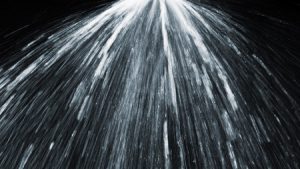
Larger commercial buildings that use large industrial ceiling fans such as warehouses or distribution centers often have other systems in place as a hazard assessment to help keep the building safe, including sprinklers.
Challenge:
Sprinklers are important for fire safety, but they can make it hard to choose the right industrial ceiling fan to properly cool a building since they have to be accounted for during a fan’s placement and installation.
Solution:
Here is a rundown of what you need to know when looking to install large industrial fans in buildings protected by sprinkler systems:
- The maximum fan diameter should be 24 ft (7.3 m).
- The HVLS fan shall be centered approximately between four adjacent sprinklers.
- The vertical clearance from the HVLS fan to sprinkler deflector shall be a minimum of 3 ft. (0.9 m).
- All HVLS fans should be interlocked to shut down immediately upon receiving a water-flow signal from the alarm system in accordance with the requirements of National Fire Protection Agency 72.
3. Loose Parts or Damage
When installing a large industrial ceiling fan, parts becoming loose can occur. Fans can travel long distances for delivery. They encounter vibration, bumps, and weather causing loose or damaged parts.
Challenge:
Loose or missing components and damage can create safety hazards or fan operation issues.
Solution:
For a gearmotor fan, listen for any unusual noises, squeaks, squeals, hum, or rubbing. Inspect thoroughly and keep up with maintenance procedures.
For gearless motors, no matter how advanced the gears on a conventional fan are, at some point, they will wear down and need to be fixed or replaced. A gearless fan uses sensors to gather operating data in real time and make power level adjustments on the fly, which further cuts down on maintenance and operating costs.
4. Material or Debris Entering the Fan
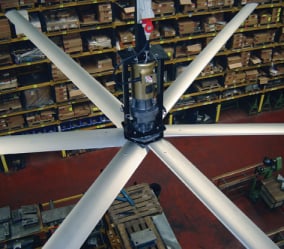
Challenge:
Certain fans are more susceptible to the dangers of an object entering the path of the fan blades. For instance, floor fans or industrial blowers are either on the ground or close to it and closer to objects that can enter into the fan. An object entering the path of a fan blade can become a projectile injury to anyone in close proximity to floor fans.
Solution:
HVLS Ceiling fans are mounted on the ceiling, far from any material or debris that could possibly enter the path of the fan blades.
5. Contact with Hot Motor Surface
Challenge:
Just like any other piece of industrial equipment within a warehouse, fan motors can reach really high temperatures after extended use.
Solution:
Let the unit have a cool-down period before starting work around fan motors.
6. Guards or Cages
Challenge:
Guards or cages keep employees from directly coming in contact with fan blades. However, even guards and cages can become an industrial fan safety hazard if not properly maintained.
Solution:
Properly secure guards and cages to the fan housing. An unsecured, guard or cage can fall, causing injury to employees. In addition, wear gloves when handling guards or cages. Guards often contain sharp edges from expanded metal and other screen materials.
Installation Safety
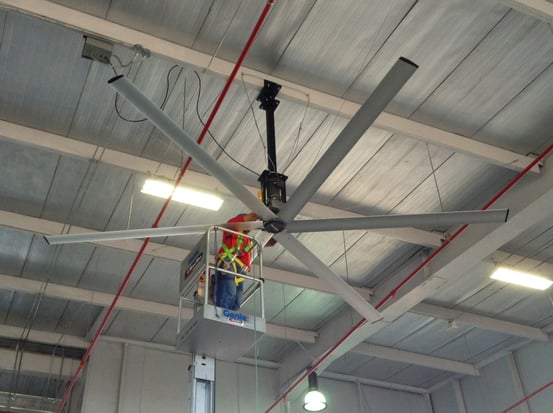
It is crucial to follow all guidelines provided by the manufacturer on how to properly install your fan. Most manufacturers and distributors offer professional installation, especially in larger facilities where multiple fans are needed. MacroAir offers a guide to the 5 most common HVLS fan installation mistakes. In addition, MacroAir offers fan installation at an additional fee.
It is crucial to make sure it is installed properly with all safety equipment provided by the fan company. This includes safety cable, Universal Mount with guy wires, blade retainer links. Confirm guy wires are correctly installed and tight where required. It’s pretty simple, just follow the installation manual instructions provided by the manufacturer. By adhering to the guidelines provided by the manufacturer of your HVLS fan and an understanding of the applicable building standards, you will have an easy time getting your HVLS fan installation completed successfully.
Other Safety Features to Consider
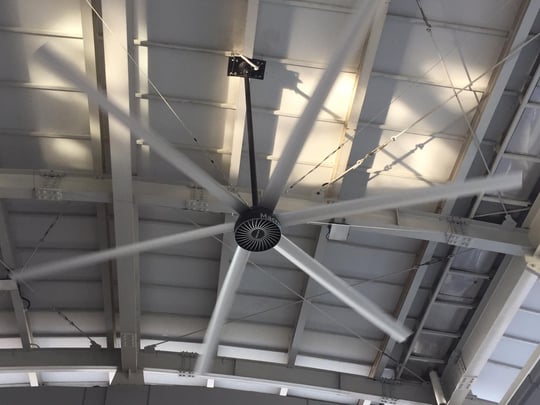
MacroAir large industrial ceiling fans come with a safety cable. Depending on the model, the fan’s safety cable either wraps around the building structure and the fan frame or comes out of the top of the fan and wraps around the building structure. The safety cable is an important part of the safety system and acts as a last resort should an earthquake, collision or similar catastrophic event occur.
MacroAir fans also include a patented interlocking safety system that keeps fan blades from detaching in extreme circumstances, guy wires to ensure the fan never falls from the ceiling, and a redundant guy wire band system that ensures guy wires remain secure. Our industrial fans are the safest on the market and include an extended warranty.


